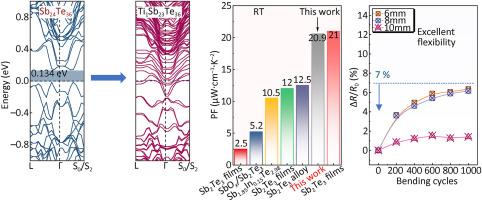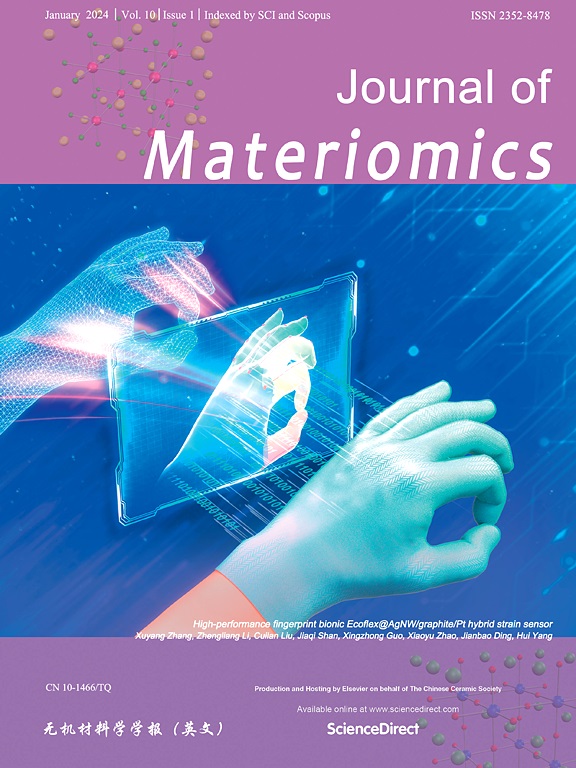Electronic state reconstruction enabling high thermoelectric performance in Ti doped Sb2Te3 flexible thin films
IF 9.6
1区 材料科学
Q1 CHEMISTRY, PHYSICAL
引用次数: 0
Abstract
Sb2Te3-based thermoelectric (TE) thin-film generators are an attractive option for wearable electronics. Band engineering can effectively modulate TE performance. However, modulating the band structure of Sb2Te3 thin film remains a challenging task. In this work, titanium (Ti) doping effectively modifies the electronic band structure in Sb2Te3, optimizing both carrier transport and phonon transport performance. Ti-doping optimizes carrier concentration and resulting in an increase in electrical conductivity from 1420.0 S/cm to 1694.8 S/cm at 300 K. Additionally, Ti doping modulates the balance between the effective mass of charge carriers and carrier concentration, increasing Seebeck coefficient from 106.0 μV/K to 114.8 μV/K. Both enhancements lead to a peak power factor of 20.9 μW⋅cm−1·K−2. Moreover, Ti-induced vibrational modes have reduced the lattice thermal conductivity from 0.62 W·m−1·K−1 to 0.22 W⋅m−1·K−1, improving zT from 0.33 to 0.52 at 300 K. The films exhibit excellent flexibility, with an ultralow resistance change ratio (ΔR/R0) of less than 7% after 1000 cycles at a 6 mm bending radius. The device achieves a maximum output power of 178.8 nW with a temperature gradient of 30 K in agreement with the finite element analysis, indicating significant potential for wearable electronics.


在Ti掺杂的Sb2Te3柔性薄膜中实现高热电性能的电子态重建
基于sb2te3的热电(TE)薄膜发电机是可穿戴电子产品的一个有吸引力的选择。频带工程可以有效地调制TE性能。然而,调制Sb2Te3薄膜的能带结构仍然是一个具有挑战性的任务。在这项工作中,钛(Ti)的掺杂有效地改变了Sb2Te3的电子带结构,优化了载流子输运和声子输运性能。ti掺杂优化了载流子浓度,在300 K时电导率从1420.0 S/cm增加到1694.8 S/cm。此外,Ti掺杂调节了载流子有效质量与载流子浓度之间的平衡,使Seebeck系数从106.0 μV/K提高到114.8 μV/K。这两种增强导致峰值功率因数为20.9 μW·cm-1·K-2。此外,钛激发的振动模式使晶格导热系数从0.62 W·m-1·K - 1降低到0.22 W·m-1·K - 1, 300 K时zT从0.33提高到0.52。薄膜表现出优异的柔韧性,在6mm弯曲半径下循环1000次后电阻变化率(ΔR/R0)低于7%。该器件的最大输出功率为178.8 nW,温度梯度为30 K,与有限元分析一致,显示出可穿戴电子产品的巨大潜力。
本文章由计算机程序翻译,如有差异,请以英文原文为准。
求助全文
约1分钟内获得全文
求助全文
来源期刊

Journal of Materiomics
Materials Science-Metals and Alloys
CiteScore
14.30
自引率
6.40%
发文量
331
审稿时长
37 days
期刊介绍:
The Journal of Materiomics is a peer-reviewed open-access journal that aims to serve as a forum for the continuous dissemination of research within the field of materials science. It particularly emphasizes systematic studies on the relationships between composition, processing, structure, property, and performance of advanced materials. The journal is supported by the Chinese Ceramic Society and is indexed in SCIE and Scopus. It is commonly referred to as J Materiomics.
 求助内容:
求助内容: 应助结果提醒方式:
应助结果提醒方式:


